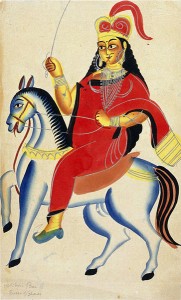Jezebel or Joan of Arc?
 In June, 1857, Lakshmi Bai, the Rani of Jhansi, belatedly committed herself and her kingdom to the revolt variously known as the Indian Mutiny, the Sepoy Rebellion, or the First Indian War of Independence.
In June, 1857, Lakshmi Bai, the Rani of Jhansi, belatedly committed herself and her kingdom to the revolt variously known as the Indian Mutiny, the Sepoy Rebellion, or the First Indian War of Independence.
A Break in Tradition
The rani had long-standing grievances against the British. She was the widow of Gangadhar Rao Niwalkar, ruler of the kingdom of Jhansi. Several months before his death, the childless raja adopted a distant cousin named Damodar Rao as his son and made a will naming the five year old boy as his heir.
Adopted heirs were an accepted practice in Indian kingdoms--both Gangadhar Rao and his predecessor were adopted heirs. Unfortunately for Lakshmi Bai and her son, under the rule of Lord Dalhousie the British began an aggressive policy of annexing Indian states on what now seem flimsy excuses, most notably the Doctrine of Lapse. The British already exercised the right to recognize the succession in Indian states with which they had client relationships. Dalhousie now claimed that if the adoption of an heir to the throne was not ratified by the government, the state would pass "by lapse" to the British. Not surprisingly, few adopted heirs were so ratified.
When Gangadhar Rao died in 1853, Dalhousie refused to acknowledge Damodar Rao as the raja's legal heir to the throne and seized control of Jhansi. Laksmi Bai, with the support of the British political agent at Jhansi and the advice of British counsel, immediately contested the decision. She continued to submit petitions arguing her case until early 1856. All her appeals were rejected.
Growing Discontent
Meanwhile, discontent had been building among the sepoys in the British East India Company's army, thanks to a number of British decisions that appeared to be designed to undermine the faith of both Muslim and Hindu sepoys and make it easier to convert them to Christianity. The final straw was the rumor that cartridges for newly issued Enfield rifles were greased with a combination of beef and pork fat. Since the cartridges had to be bitten open, such grease would make them an abomination for both Hindu and Muslim sepoys. British officers were slow to respond to the rumors. By the time they assured their men that the cartridges were greased with beeswax and vegetable oils, the damage was done. On May 8, 1857, discontent turned to rebellion at the army garrison of Meerut. Eighty-five sepoys who refused to use the Enfield rifle were tried and put in irons. The next day, three regiments stationed at Meerut stormed the jail, killed the British officers and their families, and marched toward Delhi, where the last Mogul emperor ruled in name only.
Thousands of Indians outside the army had grievances of their own against the British. Soon Indian leaders whose power had been threatened by British reforms rose up, transforming what had begun as a mutiny into an organized resistance movement across northern India.
On June 6, troops in the East India Company army in Jhansi mutinied. Two days later, they massacred the British population and soon left for Delhi. Given Lakshmi Bai's long-standing grievances against their government, the British were quick to blame her for the rising in Jhansi, though evidence for her initial involvement is thin. In fact, she wrote to the nearest British authority, Major Walter Erskine, on June 12 giving her account of the mutiny and asking for instructions. Erskine authorized the rani to manage the district until he could send soldiers to restore order.
With the region in chaos, Lakshmi Bai soon found herself under attack by two neighboring principalities and a distant claimant to the throne of Jhansi. Finding it necessary to defend her kingdom, she recruited an army, strengthened the city's defenses and formed and alliance with the rebel rajas of Banpu and Shargarh. As late as February she told her advisors she would return the district to the British when they arrived.
On March 25, Major General Sir Hugh Rose and his forces arrived at Jhansi and besieged the city. Threatened with execution if captured, Lakshmi Bai resisted. In spite of a vigorous defense, on April 3, the British broke into the city, took the palace and stormed the fort.
"The Bravest and Best"
The night before the final assault, Lakshmi Bai lashed her ten-year-old adopted son to her back and escaped from the fortress, accompanied by four companions. After riding 90 some miles in 24 hours, the rani and her small retinue reached the fortress of Kalpi, where she joined three Indian leaders who had become infamous in British eyes: Nana Sahib, Rao Sahib and Tatia Tope. Defeated again and again through May and into early June, the rebel forces retreated before the British toward Gwalior.
On June 16, Rose's forces closed in on the rebels. At the request of the other leaders, the rani led what remained of her Jhansi contingent into battle against the British. On the second day of fighting she was shot from her horse and killed. Gwalior fell soon after and organized resistance collapsed.
British newspapers named Lakshmi Bai the "Jezebel of India", but Rose compared his fallen adversary to Joan of Arc. Reporting her death to William Augustus, Duke of Cumberland, he said: "Although she was a lady, she was the bravest and best military leader of the rebels. A man among the mutineers."
In modern India, Lakshmi Bai is a national heroine. Her story has been told in ballads, novels, movies and comic books. Rose's praise is echoed in the most popular of the folk songs about her: "How well like a man fought the Rani of Jhansi! How valiantly and well!"
And speaking of road trips on the grand scale…
In Round About the Earth: Circumnavigation from Magellan to Orbit, historian Joyce E. Chaplin describes around-the-world voyages as geodramas in which travelers present themselves as actors on a global stage--a metaphor that she extends by dividing her history of circumnavigation into three "acts".
Chaplin begins with the fearful sea voyages of early modern man, when mariners who attempted to sail around the world were as likely to die as not. She moves on to the confident years of the imperial age, when circumnavigation became both a tool and a beneficiary of Western domination. She ends with the renewed fears and challenges of circling the globe that arose first with aviation and then with space travel. The dangers of orbiting the earth in a space ship are surprisingly similar to those of circumnavigating the globe in a fifteenth century caravel.
Round About the Earth is more than a series of adventures, though Chaplin tells plenty of stories about both major and minor figures in a lively and engaging voice. (Magellan, who didn't actually make it around the globe. Darwin, who never conquered seasickness. Laika, the first animal in space, whose terror, pain and death were broadcast via radio and television signals.) Chaplin intertwines her travelers' accounts with discussions of the political contexts that defined them, the technological innovations that made them easier, and, perhaps most interesting of all, the way they were reported. From bestselling fifteenth century travelers accounts to NASA's television broadcasts, circumnavigation has been about the story as much as about the adventure.
This review previously appeared in Shelf Awareness for Readers
In which I set down my road map and consider the globe
My Own True Love and I recently decided to cancel our Great River Road Trip. It was a good decision; our old cat and our old house both require our attention and the Mississippi will still be there come spring.
Under the circumstances, it seems appropriate to consider a bigger picture than road signs, road maps and our GPS. In short, globes.
Globes: 400 Years of Exploration, Navigation and Power, by professional globe-restorer Sylvia Sumira, is a history of globemaking from the late 15th through the late 19th centuries, when globes were used as educational tools, scientific instruments, and status symbols. It is also breathtakingly beautiful.
The first two sections of the book are scholarly articles in which Sumira considers not only who made globes, but why and how. The first of these, "A Brief History of Globes", is clearly for specialists. The second will fascinate anyone who has wondered how globe makers wrap a flat map around a ball--a step-by-step description of the construction of printed globes from the process of forming a papier-mâché sphere around a mold to the challenges of fitting 2-D printed sections (triangular pieces called gores) around a 3-D object.
The text is almost irrelevant next to the photographs of sixty historic globes, most of them from the collection of the British Library. They range in rarity from an unusual hand-painted globe made in 17th century China to mass-produced globes from the end of the 19th century. Sumira includes printed gores drawn by master cartographers, self-assembly paper globes made as inexpensive educational aids for children, tiny pocket globes, elaborate clockwork globes, celestial globes that map the heavens and an oddly modern 19th century teaching globe that folds up like an umbrella. The brief essays that accompany the photographs consider each object both in terms of its provenance and historical context and also as a work of art.
Certainly worth a spin, Globes will grab the imagination of anyone fascinated by maps.
This review (or at least most of it) previously appeared in Shelf Awareness for Readers.

